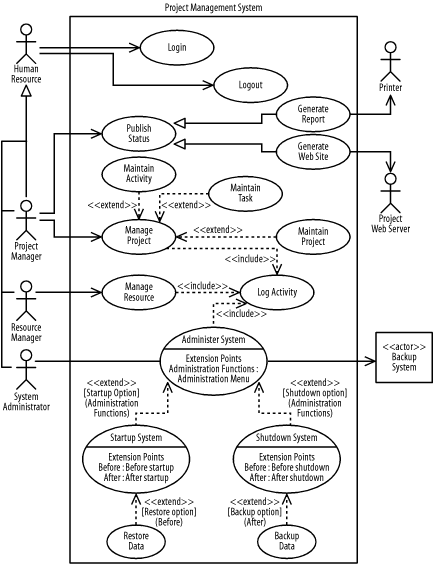4.6 Exercises
Solutions to these exercises are supplied in Section B.1.2
Describe Figure 4-14: identify actors and use cases, and describe the relationships among actors and use cases.
Figure 4-14. Use-case diagram for the project management system

Update the diagram shown in Figure 4-14 stepwise to show the following details. After each step, check your answers against the solutions shown in Appendix B:
A human resource may manage his professional development plan. When managing his professional development plan, the human resource may manage his profile. In managing his professional development plan, he will have access to a training schedule provided by a training database, and all the information pertaining to his professional development plan will be stored in a professional development plan database. Both databases are not part of the project management system.
When a resource manager manages resources, she will have access to resource functions that are provided on a resource menu. One option is to manage a resource's profile. This is the same functionality used by human resources to manage their profiles.
A project manager or system administrator, acting as an email user, may send email using an email system that is not constructed as part of the development effort (it may have been purchased). When sending email, the manager may select a secure option wherein his whole interaction with the system is secured using a purchased encryption engine. Note that this is not simply encrypting the sent email message, but encrypting the entire interaction as the email is composed and sent.
An email system may be used to receive email messages. When a message is received, the email user is informed. Likewise, an email user may query the system to check whether new messages have arrived, depending on how often her system is set up to check for new messages.
When sending or receiving email, the system logs the transaction. This functionality for logging transactions may be used by other use cases in the future.
Given Figure 4-14 and the solution to question 2, describe the general order in which the use cases shown in the resulting diagram must be developed; that is, what use cases must be developed before other use cases (independent of users prioritizing the use cases)?







